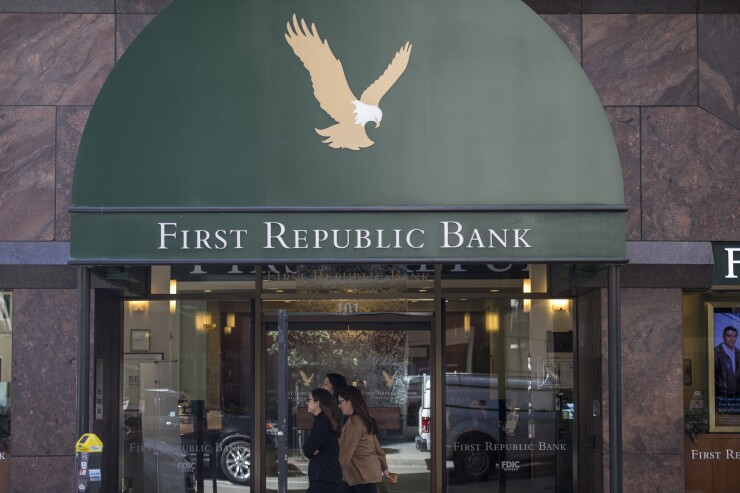First Republic Bank, which recently warned investors that it expects to struggle with margin compression in the near term, has reduced its guidance amid ongoing funding pressures.
At the same time, the San Francisco-based company says it is committed to doing what it can to keep its loan growth piping hot.
First Republic now projects that its net interest margin will be about 2.45% for the fourth quarter and it could move even lower next year, executives said Wednesday during an investor day in New York City. For full-year 2023, the margin could fall between 2.30% and 2.35%, the company said.

Four weeks ago on an earnings call, executives
But this year's spate of interest rate hikes by the Federal Reserve — which has now
Checking deposits, which made up 72% of First Republic's total deposit base on June 30, fell to 64% as of Sept. 30, while the percentage of deposits held in CDs rose from 4% to 9% during the same time period, the company said. And that migration is likely to persist for several quarters.
By late 2023, checking deposits are expected to decline to "a little bit above 50%," Roffler said.
"A lot more conversations happen with clients about, 'Oh, I could actually get a little bit of yield on my dollars now,' " Roffler said Wednesday. "So we talk about that, and we're there to serve."
The idea of serving customers was pervasive throughout First Republic's first investor day since 2019. A lot of the discussion focused on the bank continuing to make "safe" loans in a rising rate environment. Loan growth at the $205.1 billion-asset company has been
First Republic would like to keep it that way, despite funding challenges and what Executive Chairman James Herbert called the "temporary compression" of the margin, which ended the third quarter at 2.71%.
The company is now guiding for fourth-quarter loan growth that exceeds 20% year over year. For full-year 2023, executives are projecting loan growth in the mid-teens, largely reflecting the downturn in mortgage refinancing activity.
Herbert predicted that First Republic's new household acquisition rate will be 50% higher than normal when the current rate cycle ends because of the company's focus on meeting its customers' needs.
"Others are going to pull back or already are, and it's just getting started," Herbert said. "You watch these next six months. That service is going to go down, [the] opportunity to differentiate ourselves is going to go up, and we're going to take in new clients."
Still, given the margin compression, the company is looking to reduce expenses, which could rise by low double digits in 2023, according to First Republic executives.
The list of possible ways to cut costs includes slowing headcount growth, which has been around 15% for the past year, and deferring about $100 million of planned spending that can be put off until after next year, executives said.






